Gabriela Ortiz’s "La Calaca" celebrates the colorful dance between life and death

Picture a skeleton. What do you see? A ghastly visage, a grim reminder of mortality, or a simple scientific projection?
Now picture a skeleton dancing. What music do you hear? Is it something mysterious and gothic? Or perhaps festive ... and even a little fun?
Gabriela Ortiz’s La Calaca falls firmly into this latter category. It is a vivid and rhythmically driven orchestral work that captures the joyful relationship with death found in Mexican culture.
La Calaca is one word in Spanish for "skull" or "skeleton," specifically referencing the skeletal figures that are central to Día de los Muertos celebrations. They’ve recently been featured in big U.S. pop culture moments such as the 2017 Pixar movie Coco, and the opening scene of the 2015 James Bond movie Spectre.
In Mexican tradition — a tradition that dates back to the Mayas, long before Spanish colonialism — calacas are not macabre or frightening; they are often depicted laughing, dancing, wearing colorful clothing, or playing instruments. These images represent a cultural view of death as something that's not grim or menacing, but as a natural and even festive part of life.

This joyful attitude toward mortality is at the heart of Ortiz’s composition. The 10-minute piece brims with energy and mixes in a native Huichol melody from the western Mexican state of Nayarit, evoking what Ortiz calls "a musical world full of joy, vitality, and a great expressive force."
Originally composed as just one movement of a larger piece for string quartet and Central American indigenous instruments, Ortiz reimagined La Calaca in 2021 as a standalone work for string orchestra. La Calaca premiered in Ojai, California in 2021 and came to Tanglewood for the first time in 2024. It has also enjoyed performances in Mexico City, Los Angeles, and New York’s Carnegie Hall before returning to Tanglewood as part of the 2025 Festival of Contemporary Music, curated by Ortiz herself.

Ortiz’s musical language reflects her deep connection to both Western classical and folk Mexican traditions. The daughter of musicians from the renowned folk group Los Folkloristas, Ortiz was immersed in traditional Latin American music from a young age. Without fail, she brings those musical flavors to her compositions, which often deal with Mexican culture and social justice themes.
Her reputation has soared in recent years, with support from major figures like Gustavo Dudamel and ensembles including the Los Angeles Philharmonic. Her works — such as the Grammy-winning Revolución diamantina — are being performed widely, including a performance by the BSO in February 2025. In La Calaca, Ortiz transforms the image of the skeleton into a vibrant, dancing force, inviting listeners to embrace life and death with equal celebration.
Maya Shwayder is the BSO’s Senior Contributing Editor and Copywriter.
References
Gabriela Ortiz orchestral works
La Calaca for String Orchestra | The St. Paul Chamber Orchestra
Death comes alive with calacas, Mexico’s skeletal figures | Mexico News Daily
Program note by Robert Kirzinger, Thursday Aug. 15, 2024, 8:00pm performance at Tanglewood of "La Calaca" by The Knights in Seiji Ozawa Hall.



